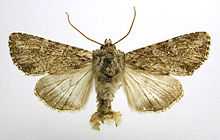Apamea anceps
| Apamea anceps | |
|---|---|
 | |
| Scientific classification | |
| Kingdom: | Animalia |
| Phylum: | Arthropoda |
| Subphylum: | Hexapoda |
| Class: | Insecta |
| Order: | Lepidoptera |
| Family: | Noctuidae |
| Tribe: | Apameini |
| Genus: | Apamea |
| Species: | A. anceps |
| Binomial name | |
| Apamea anceps (Denis & Schiffermüller, 1775) | |
| Synonyms | |
| |
The Large Nutmeg (Apamea anceps) is a moth of the Noctuidae family.
Geography
The Large Nutmeg is distributed throughout Europe and through the Palearctic to Yakutia, Transbaikalia, Lebanon , Armenia, Asia Minor, Irana, Mongolia East Siberia, China (Shaanxi) and Japan. It is also found in North West Africa.
Description
- See glossary for terms used
The wingspan is 35–40 mm. Forewing grey speckled with darker, and more or less tinged with brown; the veins dark; inner and outer lines double, dark filled in with pale ground colour, conversely lunulate-dentate; the inner line sometimes forming a sharp outward angle below vein 1, meeting the median line, sometimes rounded ami remote from it: claviform brown, darker-edged, variable in size, often quite small; orbicular and reniform pale with dark centres, the latter with white dotted annulus and often followed by a pale patch; marginal area dark grey beyond the pale submarginal line, which is preceded by brownish patches at costa and on both folds: hindwing dirty whitish, with darker cellspot, veins, and outer line, the terminal area diffusely fuscous, with the submarginal line showing paler along termen; in typical sordida the brown tints are confined to the two folds: -in anceps Hbn. these brown tints pervade more or less the whole forewing: - ochracea Tutt has the ground colour paler and the suffusion more rufous brown;renardii Bsd. is a very pale form with the markings subobsolete; while engelhartii Duurloo represents a renardii pale form from E. Jutland with indistinct markings; - ab. mediana ab. nov. [Warren] appears very distinct; the brown grey ground colour is without dark speckling; the inner and outer lines are single, black and distinct, the outer with clear black teeth on the veins; the median shade, generally inconspicuous, is thick and black, distinctly angled outwards on subcostal and veins 1 and 2; the space between it and outer line deeper brown: the markings of the hindwing clearer; the male specimen from Germany without precise locality.[1]
Adults are on wing from June to July.
Larvae
The larvae feed on the flowers and leaves of various grasses, including Poa annua and Dactylis glomerata.[2]
References
- ↑ Seitz, A. Ed., 1914 Die Großschmetterlinge der Erde, Verlag Alfred Kernen, Stuttgart Band 3: Abt. 1, Die Großschmetterlinge des palaearktischen Faunengebietes, Die palaearktischen eulenartigen Nachtfalter, 1914
- ↑ "Robinson, G. S., et al. 2010. HOSTS - A Database of the World's Lepidopteran Hostplants. Natural History Museum, London.".
External links
| Wikimedia Commons has media related to Apamea anceps. |
- Lepiforum Includes photo of genitalia
- Funet Taxonomy
- Fauna Europaea
- UKmoths